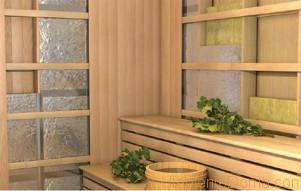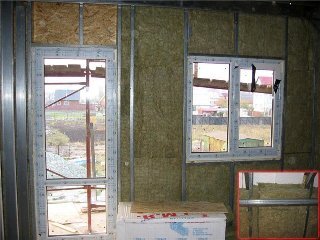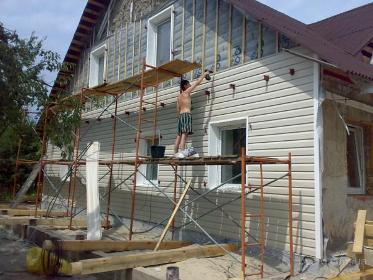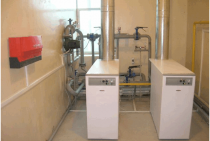The main types of heaters
To date, there are two optimal options: mineral wool (or glass wool) and foam. Each of these materials has its positive and negative qualities.
Mineral wool is produced either in rolls or sheets. The material has such positive aspects:
- the thermal conductivity index has a value of 0.041 W / (m ° C), this characteristic may vary depending on the density of the material itself, but such a change will be insignificant;
- good sound insulation, here density is of great importance;
- fire resistance: if a fire occurs, then in the absence of an open fire, the material will quickly fade;
- ease of fixing: the structure of mineral wool makes it easy to cope with uneven surfaces, besides, it is easy to eliminate voids.
But this material also has disadvantages:
- poor moisture insulation: if such cotton wool gets wet, then the thermal insulation will deteriorate by 2 times;
- the installation technology itself has more complex features;
- rolls tend to roll, this factor is affected by the dishonesty of contractors or improper self-insulation of walls made of cinder blocks.
Styrofoam (extruded polystyrene foam), unlike the first option, is denser in structure, which makes it more durable. The level of moisture absorption is about 10 times lower than that of mineral wool. But all the qualities are significantly reflected in the price of the material.
Styrofoam can be presented in the form of plates, less often in rolls. Of the positive aspects of such material, the following can be noted:
- good resistance to moisture: even if water gets on the surface, the thermal insulation properties of the wall will not lose;
- applicable on flat areas, while covering them well;
- depending on the use of certain grades, it may have good fire resistance, therefore, like mineral wool, if there is no open fire near the hearth, this material will quickly die out.
Among the negative points, the following characteristics should be highlighted:
- low level of sound insulation;
- some types of foam absolutely do not tolerate fire, therefore, when insulating the walls of the house, you should carefully select the brand, otherwise during a fire it can emit acrid smoke and support the fire itself;
- this material of the usual type has a rather fragile structure, which, in turn, leads to certain problems in installation.
There is an opinion that rodents like this material. But it is not so. Rodents do not eat polystyrene, but they equip their dwelling in it, as it is warm enough.
How easy it is to insulate a cinder block house. Insulation of a cinder block house
Houses built from cinder blocks, unlike their wooden and brick counterparts, need additional insulation from the outside. The thermal conductivity index of a cinder block varies between 0.35-0.6 W / (m 0C), which means that in order to ensure normal temperature in the house in our harsh climate, it would be necessary to build a building from cinder block slabs with a thickness of about 1.5- 2 meters, which is extremely unprofitable. That is why buildings made of cinder block slabs of standard thickness are additionally insulated from the outside.
External or internal insulation to choose? Professional builders recommend insulating a cinder block house precisely from the outside, since after laying the heat-insulating layer inside the room, the dew point located between the coolant and the wall shifts. As a result, moisture will accumulate on the walls, contributing to the spread of moldy fungi.
Another disadvantage of internal insulation is that the heat-insulating material "steals" centimeters of the area of \u200b\u200bthe room.That is why it is rational to insulate a cinder block house from the outside.
Technology of insulation of building structures
Thermotechnical calculations and instrumental measurements show that 5-10% of heat leaves the housing through the floor and ground, 20-30% through walls and the same amount through attic floors and roofs. For these building structures, slag insulation can be used.
The sequence of work to improve the thermal insulation characteristics for the floor, ceiling, walls is different.
Floor insulation
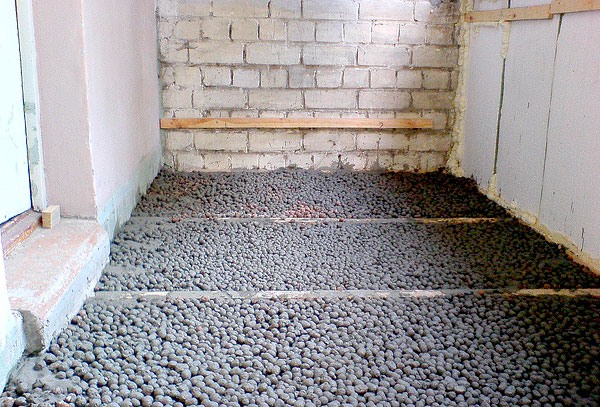
Depending on the design of the dwelling, floor insulation with slag in private houses is carried out in different ways. If in the spring and after heavy rains in the underground, the basement appears water, be sure to make waterproofing.
Brief instructions for warming the earthen floor:
- The surface is freed from debris, leveled, if necessary, rammed.
- They equip the waterproofing, for which they cover the floor with clay dissolved in water and thoroughly mixed to a dough state. Another option: spread a layer of waterproofing roll material, glue the joints with mastic.
- Carefully pour a layer of insulation of the required size - the thicker the better. For most regions, it is enough to pour 15 - 20 cm.
- Pour 5 cm of sand, ram.
- Pour a cement-sand screed (CPS) 5 - 10 cm.
If the height of the ceilings in the basement does not allow to equip such a "pie", you can fill the floor with concrete, using slag as a filler. Before pouring, they arrange a sand cushion, which is spilled with water and rammed.
The sequence of work is simple:
- Remove debris, dirt, dust.
- Cracks and technological holes are sealed with cement mortar.
- The plate is treated with an antiseptic to prevent the occurrence of mold and fungus.
- They cover the surface with a layer of vapor barrier film (membrane), which will prevent the penetration of vapors from the basement, but will allow moisture to evaporate into the underground room. In houses with dry basements, vapor barrier is not needed.
- DSP is performed on top of the heat insulator layer.
- After drying, finish with finishing materials (laminate, chipboard, linoleum).
Ceiling insulation
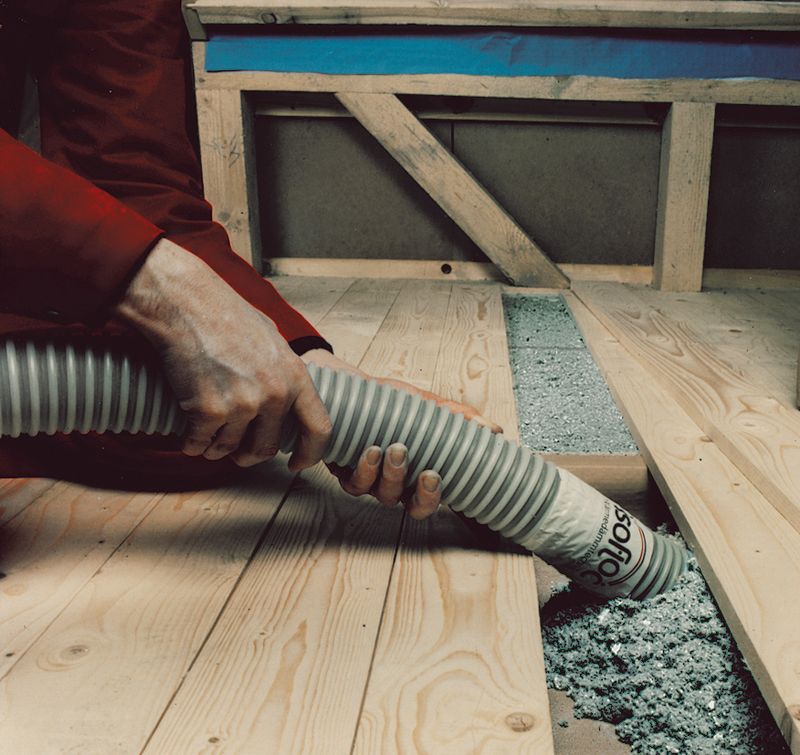
Technologically, the work on warming the floor and ceiling does not differ.
Before insulating the ceiling with slag, it is necessary to carry out calculations so as not to give the structures an excessive load. To do this, you need to find out the bearing capacity of the floor slabs and compare it with the mass of the backfill.
Slag as a ceiling insulation has the same pros and cons as when used in other building structures.
The height of the non-residential attic allows you to pour a layer of any required thickness (taking into account the characteristics of the plates). The insulation will retain its properties throughout the life of the house.
In order for the slag for insulation of ceilings to retain its properties, precipitation should not fall on it. The dormer window should not be closed tightly - this will help the moisture to evaporate in a timely manner.
- Floor slabs are covered with a layer of waterproofing.
- Fall asleep the right amount of backfill.
- Equip a concrete screed with a thickness of 10 - 15 cm, observing a slope to drain water during precipitation.
- Carry out waterproofing with rolled materials.
In order for the coating to last for a long time, follow the instructions of manufacturers of building materials.
Insulation of hollow walls
Wall insulation with slag does not require special preparations. Any slag is poured between the outer and inner layers of the brick as the wall is built. It is better to choose a porous material of the middle fraction. Such characteristics will make the house warmer, there will be no voids between the pieces of backfill.
Advantages and disadvantages
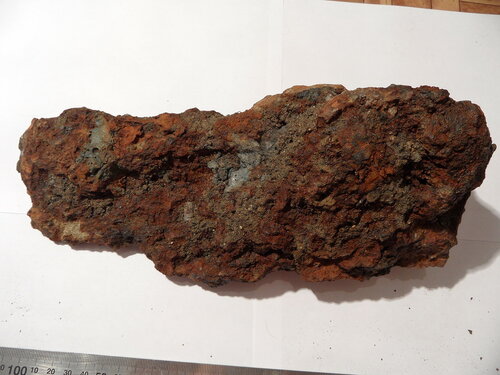
Despite the difference in technical characteristics, all types of slags as heaters have similar positive qualities.
The material is different:
- ease of use;
- low cost;
- optimal air exchange;
- resistance to decay, the formation of fungus, the spread of mold;
- possibility of use in any premises;
- mechanical strength and chemical neutrality;
- inaccessibility to damage by rodents and insects;
- good thermal conductivity compared to monolithic concrete or brick;
- unlimited time of use subject to the installation technology;
- fire safety.
The structure of the material imposes restrictions on the application. High specific gravity is taken into account when designing load-bearing structures.
Slags are less effective than modern specialized products for thermal insulation - foam plastic, penoizol, mineral plates, etc.
The metallurgical type is prone to rust in high humidity conditions.
Industrial types of insulation are hidden with a screed or poured into the voids of brickwork to prevent harmful substances from entering the air of residential premises.
Material types
From the waste of metallurgical industries and the energy industry, the following types of insulation are obtained:
- domain;
- metallurgical;
- fuel and coal.
Different types are used to insulate the structural elements of the house.
Domain
The material is obtained by smelting iron. The composition includes the remains of rock, fluxes and fuel ash. The pieces are very porous, the material is loose.
In private construction, a fine (heavier) fraction is used to fill cavities in walls or under a screed of concrete floors. Large fraction - light in weight - suitable for backfilling attic floors.
This type of raw material is used for the manufacture of slag heat-insulating materials.
The most suitable for insulation is slag pumice, which has good heat and sound insulating properties. It also goes into the cinder block filler.
Metallurgical

This type often includes waste from nickel and copper smelters, steel mills.
The material is sintered pieces of various fractions. They contain a lot of metal oxides, which is why the mass of the composition is large.
fuel
The raw materials for the manufacture are the remains of fuel oil and coal burned in boiler rooms. The fraction and properties depend on the type of combustion (chamber or stratified).
Fuel residues are hygroscopic, therefore must be dried for at least 2 months without exposure to precipitation before backfilling.
It is used for filling cavities in brick walls or under a concrete screed on the floor and ceilings.
How to insulate cinder block walls from the inside
The steam room in the bath is insulated from the inside.
Internal insulation of a cinder block house is not welcome, except that, for example, special paint with ceramic hollow spheres or penofol can be used as additional thermal insulation. As independent materials, they are ineffective. Thermal insulation of cinder block walls from the inside is practiced in steam saunas, when it is additionally necessary to protect the walls from moisture. In this case, the main thing is to prevent moisture from the steam room from getting into the insulation layer. Naturally, only mineral wool can be used. Method of work:
- a wooden frame is being erected on the inside of the walls in the steam room;
- mineral wool is laid between the guides, preferably basalt;
- foil insulation is spread over the crate - it is very effective for saunas, as it covers IR radiation and does not let steam through;
- the second tier of the crate is installed on top of the penofol;
- a wooden lining is attached to the second tier.
Mineral wool must be laid in two layers and make sure that the joints do not match. The minimum insulation layer is 10 cm. The main thing is not to forget to glue the foam foam joints with special (not clerical) tape. Also, you can not neglect the ventilation gap between the penofol and the wooden lining.Without it, the reflective insulation simply will not work, besides, the condensate on the foam should evaporate. Penofol foil often has small holes that are invisible to the eye. Therefore, in order to be safe, you need to lay a vapor barrier membrane under the penofol.
What are the materials for insulation
There is a fairly large number of materials. They are distinguished from each other by some important criteria. These include:
- Thermal conductivity. The best thermal insulation material has a lower rate.
- Moisture resistance. The more insulation tends to absorb moisture, the better you need to do waterproofing.
- Flammability. It is advisable to choose a material that will not be flammable.
- Durability. Some isolate tends to wear out quickly and become unusable under certain conditions. This should be taken into account when choosing it.
- Environmental friendliness.
When answering the question, what is the best way to insulate the ceiling, you can consider the following options:
- mineral, basalt, glass or ecological wool;
- polystyrene foam or extruded polystyrene foam;
- expanded clay;
- PPU or penoizol;
- shavings or sawdust;
- tree leaves (usually oak) and straw.
Sometimes in the baths the ceiling is insulated with earth or sand. However, this is quite rare. Leaves and straw are not used as often. This is an environmental material that does not have durability and moisture resistance. Therefore, for its installation, it is necessary to know and strictly follow the technology.
Another important criterion is applied to the ceiling insulation - low weight. Thermal insulation should not weigh down the structure of the ceiling. In this regard, earth and sand are rarely used and more often for non-residential premises.
Let's consider each material in more detail.
General recommendations
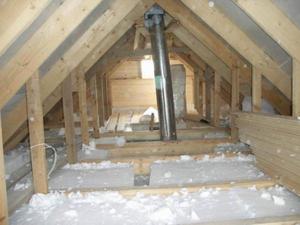
If the attic is planned to be used as an attic, then the thermal insulation should consist of three layers: vapor barrier (laid with the rough side down, smooth - to the thermal insulation), a thermal insulation layer and waterproofing
It is extremely important to do this, because the residential part of the house is under the ceiling, and the warm air rising to the floors contains so much steam that it can easily ruin any thermal insulation.
Before starting work on insulation, it is necessary to check the condition of the roof, as well as beams, if we are talking about wooden floors. They must be protected from moisture with a special composition.
It would be a mistake not to leave gaps in the thermal insulation layer. They will be needed to provide the necessary ventilation of the room and prevent the formation of condensate or the accumulation of moisture under the roof.
In addition, all work must be carried out in dry weather, and even better - in the warm season.
Wall insulation with polystyrene foam
Styrofoam laying is carried out in almost the same way as the installation of mineral wool.
The first step is surface preparation. Elimination of defects and application of a primer. Further, after preparing the adhesive solution, we proceed to the installation of insulation sheets.
Important: there should be no gaps between the plates!
After laying the insulation boards on top of them, you need to fix the reinforcing mesh. Further, this whole cake is carefully primed and puttied, after which you can proceed to the final stage - applying a decorative coating.
When a house is insulated from the inside, the interior space of the room is significantly reduced. However, this fact is not critical in order to completely abandon the insulation and suffer from low temperatures outside the window in the cold season or throw funds into the chimney to heat the house.
Before answering the question of how to properly insulate a cinder block house from the inside, it is necessary to deal with the materials offered by hardware stores. Today, the market offers insulation based on foam and mineral wool. Installation of both one and the other does not require any specific skills from the performer.
We insulate the cinder block house with foam plastic
The complexity of the installation of this material lies in the preliminary alignment of the walls on which they will be glued. In the case of a brick wall, plastering and puttying will be required. Without fail, the wallpaper must be removed from the walls and the remnants of paint removed.
Every owner of an apartment or house is undoubtedly dominated by the desire to preserve the final result for the longest possible time. That is why the use of a waterproofing substrate, even inside the house, must be indispensable. For what? In order to prevent the accumulation of foam-destroying condensate.
For work you will need:
- five-centimeter polystyrene;
- comb or notched trowel;
- glue (usually Ceresit).
Installation work is extremely easy. On the prepared wall, with the help of diluted glue, insulation plates purchased at the building materials store are attached. Then they are thoroughly tapped to remove possible air bubbles from under them. In this matter, the important point is the application of the adhesive mixture directly to the wall and in no case to the foam sheets themselves. They must always be dry.
Further, for optimal insulation of the house, all cracks and loose fittings of the material should be treated with mounting foam. This must be done in order to isolate the glued layer from changes in humidity in the room.
In the process of fixing foam boards, you can also use special fixing dowels. However, an adhesive solution will be sufficient. The final step will be the front decoration of the walls and their possible painting.
Quite fast and practical. Its most important advantage is the elimination of the preliminary leveling of the walls. The thing is that mineral wool slabs are installed in a specially created metal structure. Then, in stages, the entire frame is sewn up with plasterboard plates, which will give your wall a perfectly flat surface.
So, a special design is assembled from metal or wooden profiles - crates. Plasterboard plates are installed on it. Next, the joints are puttied and the wall is either painted or wallpaper is applied to it.
You will also be interested in:
Most often, the developer thinks about conducting thermal insulation of a house from cinder blocks with his own hands after the object has been erected. This is largely due to the fact that cinder blocks seriously differ in their thermal conductivity.
Such an indicator can be in the range of 0.35-0.6 W / (m K). Thus, it is very difficult to determine in advance how well cinder blocks can insulate the interior space.
Why does a cinder block house need insulation?
Based on the building codes reflected in SNiP 23-02-2003, only 1.5-2 m can be considered normal wall thickness from cinder blocks, but such thick walls are extremely expensive. Suffice it to say at least that for such a structure it will be necessary to build a massive and expensive foundation.
In order for the walls of the cinder block house to be able to retain heat in the home, the best option would be to perform thermal insulation. Then it will be possible to save money, provide conditions for a pleasant microclimate, and also make the house more aesthetic.
Insulation with expanded polystyrene
Most often, thermal insulation is made with a sheet of foam or foam plastic. These are the most common polystyrene foam insulation materials.In terms of thermal conductivity, it is on a par with mineral wool. However, unlike her, it does not have high moisture resistance and is harmless to humans. Therefore, the insulation of the ceiling with foam or polystyrene is often done from the side of the residential part of the room. The use of any of the materials will achieve a balance in terms of price and quality.
Like any other insulation, this one needs hydro and vapor barrier so that condensation does not form. After all, moisture destroys the ceiling. As such isolation, it is permissible to use:
- isospan;
- penofol;
- special films and membranes;
- penetrating mixtures and others.
Despite the fact that sometimes the ceiling is insulated with penofol, it is sometimes used for waterproofing. Thermal insulation is carried out with penofol from the inside of the room. Because it has one foil side, this will reflect heat into the interior of the rooms.
Since polystyrene is cheaper than polystyrene foam, it is often used for insulating an apartment building, in a cellar for wall insulation, in apartments on floors and walls outside, on the attic floor of private houses. This material is perfect if you are thinking about how to insulate the ceiling in the country. Residents of apartment buildings rarely lay heat insulation on the ceilings. Since the apartments are located on top of each other, heat loss occurs only through the outer walls. Styrofoam is placed on concrete floors so that the cold does not pass from below. This is mainly done by the owners of the lower floors, where the earth transmits cold in winter. In this regard, they insulate the ceiling in the apartment on the top floor, since it is not possible and advisable to put the material on the walls of the attic from the inside with your own hands.
Insulation of the cellar with foam plastic can be carried out from the inside. This is especially true when the cellar is the basement. However, you should be careful, because there is a high probability that condensation will appear. The use of hydro and vapor barrier will correct this drawback. A kind of pie is being made: inside it are plates of expanded polystyrene, and along the edges of the sheet are layers of insulation.
